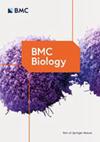Endosomal protein DENND10/FAM45A integrates extracellular vesicle release with cancer cell migration
IF 4.4
1区 生物学
Q1 BIOLOGY
引用次数: 0
Abstract
Mounting evidence shows that tumor-derived extracellular vesicles (EVs) are critical constituents in the tumor microenvironment. The composition and function of EVs often change during cancer progression. However, it remains less clear how cancer cells modulate their own EV biogenesis to promote tumor development. The release of EVs is closely linked to the endolysosome system residing within the cell. The current study aims to decipher the role of endosomal protein DENND10 in cancer development. Bioinformatics data mining showed that DENND10 expression is significantly associated with poor prognosis in multiple cancer types and up-regulated in metastatic breast cancer cell lines. DENND10 knockout (DENND10-KO) in breast cancer cells led to defective EV biogenesis due to impaired endolysosomal trafficking. Intriguingly, DENND10-KO cells exhibited reductions in cell spreading, migration, invasion, and metastatic potential in vivo. These deficiencies in cell motility were associated with compromised cytoskeleton organization. Importantly, wild-type conditioned medium or EVs restored the migratory ability and cytoskeletal organization of DENND10-KO cells. Global proteomic profiling revealed that DENND10 depletion led to a distinct EV compositional landscape with remodeled profiles of extracellular matrix (ECM) and adhesion molecules. Consistently, exogenous application of ECM molecules rescued the spreading and migration of DENND10-KO cells. In summary, our study unveiled DENND10 as an intrinsic regulator of cell migration that modifies the tumor microenvironment through autocrine EV release, which could be exploited for developing targeted therapies for tumor metastasis.内体蛋白DENND10/FAM45A将细胞外囊泡释放与癌细胞迁移结合在一起
越来越多的证据表明,肿瘤衍生的细胞外囊泡(EVs)是肿瘤微环境的重要组成部分。在癌症发展过程中,EVs 的组成和功能经常会发生变化。然而,目前仍不太清楚癌细胞如何调节自身的EV生物生成以促进肿瘤的发展。EVs 的释放与细胞内的内溶酶体系统密切相关。目前的研究旨在破译内质体蛋白DENND10在癌症发展中的作用。生物信息学数据挖掘显示,DENND10的表达与多种癌症类型的不良预后显著相关,并在转移性乳腺癌细胞系中上调。在乳腺癌细胞中敲除DENND10(DENND10-KO)会导致内溶酶体转运受损,从而导致EV生物生成缺陷。耐人寻味的是,DENND10-KO 细胞在体内表现出细胞扩散、迁移、侵袭和转移潜力的降低。细胞运动的这些缺陷与细胞骨架组织受损有关。重要的是,野生型条件培养基或EV可恢复DENND10-KO细胞的迁移能力和细胞骨架组织。全局蛋白质组分析表明,DENND10耗竭导致了不同的EV组成景观,细胞外基质(ECM)和粘附分子的轮廓发生了重塑。同样,外源应用ECM分子可挽救DENND10-KO细胞的扩散和迁移。总之,我们的研究揭示了DENND10是细胞迁移的内在调控因子,它通过自分泌EV释放改变肿瘤微环境,可用于开发肿瘤转移的靶向疗法。
本文章由计算机程序翻译,如有差异,请以英文原文为准。
求助全文
约1分钟内获得全文
求助全文
来源期刊

BMC Biology
生物-生物学
CiteScore
7.80
自引率
1.90%
发文量
260
审稿时长
3 months
期刊介绍:
BMC Biology is a broad scope journal covering all areas of biology. Our content includes research articles, new methods and tools. BMC Biology also publishes reviews, Q&A, and commentaries.
 求助内容:
求助内容: 应助结果提醒方式:
应助结果提醒方式:


